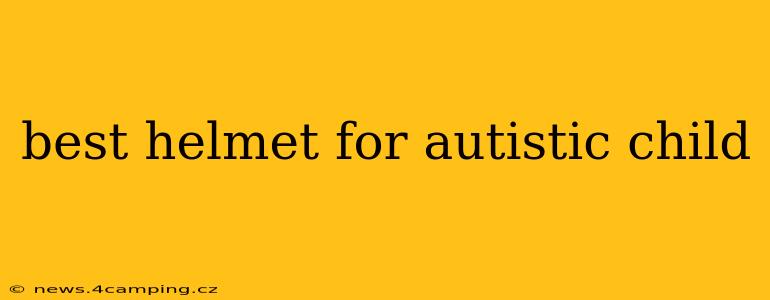Finding the right helmet for your autistic child can feel like navigating a minefield. It's not just about safety; it's about finding a helmet that fits comfortably, minimizes sensory overload, and encourages cooperation during wear. This guide will help you navigate the process, addressing common concerns and offering valuable insights.
While there isn't a specific "autistic helmet," understanding your child's unique sensory needs and preferences is crucial. This guide will help you choose a helmet that addresses those needs, promoting safety and comfort.
What Makes Helmet Selection Different for Autistic Children?
Many autistic children experience sensory sensitivities that impact their tolerance of certain textures, sounds, and pressures. A helmet that's perfectly fine for a neurotypical child might be incredibly uncomfortable or even distressing for an autistic child. Consider these factors:
- Sensory Sensitivities: Some children may be sensitive to certain materials (e.g., rough textures, scratchy fabrics), weight, or the feeling of pressure on their head.
- Movement and Restriction: The helmet's fit and design influence movement and can impact balance and coordination, which might be particularly challenging for some autistic children.
- Preference for Specific Colors or Styles: A child might strongly prefer specific colors, patterns, or designs. Choosing a helmet that aligns with these preferences can significantly increase cooperation.
- Communication Challenges: Communicating discomfort can be difficult for some autistic children, making it essential to carefully observe their reactions and body language.
Choosing the Right Helmet: Key Considerations
1. Fit and Comfort: The most important factor is a proper fit. A helmet that's too tight can cause discomfort and headaches, while one that's too loose won't provide adequate protection. Look for adjustable straps and sizing options to ensure a snug but comfortable fit. Consider the weight of the helmet; a lighter helmet will likely be more comfortable for extended wear.
2. Material and Texture: Opt for smooth, soft, and breathable materials. Avoid helmets made of rough or scratchy materials that might irritate the skin. Many helmets are made from expanded polystyrene foam (EPS) covered in a shell; the shell's material is what determines the texture.
3. Ventilation: Good ventilation is crucial to prevent overheating, especially during physical activity. Helmets with ample vents will keep your child cooler and more comfortable.
4. Design and Aesthetics: Involve your child in the selection process if possible. Let them choose a color, design, or character they like. This can make them more receptive to wearing the helmet.
5. Safety Features: Look for helmets that meet relevant safety standards (e.g., CPSC in the US, CE in Europe). These standards ensure the helmet is rigorously tested and offers sufficient protection in the event of a fall.
H2: What are the best brands of helmets for children with autism?
There isn't a specific brand marketed solely for autistic children. However, many reputable brands offer helmets with features that may be better suited to their needs. Consider brands known for comfortable, lightweight, and well-ventilated designs. Research reviews, focusing on feedback about comfort and fit. Prioritize visiting a local retailer to try on different helmets to assess fit and comfort.
H2: How do I get my autistic child to wear a helmet?
Getting an autistic child to wear a helmet requires patience, understanding, and positive reinforcement.
- Positive Introduction: Introduce the helmet in a positive and playful manner.
- Sensory Preparation: Let your child touch and explore the helmet before wearing it.
- Gradual Adaptation: Start with short periods of wear and gradually increase the duration.
- Reward System: Implement a reward system to motivate helmet wearing.
- Professional Support: If challenges persist, consult with an occupational therapist or other relevant professional who can provide personalized strategies.
H2: Are there any special helmets designed for children with sensory processing disorder?
While there aren't helmets specifically labeled for sensory processing disorder, the principles for selecting a helmet for an autistic child apply equally to a child with SPD. Prioritize comfort, proper fit, and breathable materials.
Conclusion
Selecting a helmet for your autistic child requires a careful consideration of sensory needs, comfort, and safety. By understanding these factors and involving your child in the selection process, you can find a helmet that provides optimal protection while minimizing discomfort and promoting cooperation. Remember, patience and positive reinforcement are key to ensuring your child wears their helmet safely.
